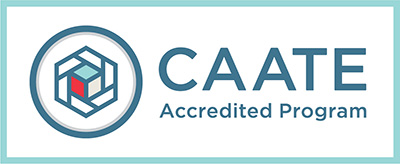
Athletic Training Curriculum
The MSAT Program at Moravian University is a two-year, professional graduate program designed to prepare students for entry-level practice as Athletic Trainers. The MSAT Program at Moravian University is subdivided into two major divisions, known as the Academic Program and the Clinical Education Program. Successful completion of the MSAT Program requires successful completion of both these components. A student completing the Academic Program is required to complete all required courses for the MSAT degree. This program consists of thirty-three (33) courses comprising sixty-nine (69) credit hours. An overview of the academic program can be found below and more detailed course descriptions can be found in Moravian University's course catalog.
1st Year Courses
| HLAT 500: Anatomy & Physiology (first 5 weeks) |
| HLAT 501: Introduction to AT 1 (first 5 weeks) |
| HLAT 502:Introduction to AT 2 (second 5 weeks) |
| HLAT 505: Emergency Care (second 5 weeks) |
Fall Semester 1 (August-October)
| HLAT 511: Evidence-Based Practice 1 |
| HLAT 531: Lower Extremity Assessment |
| HLAT 541: Therapeutic Interventions 1 |
| HLAT 582: Clin Ed 2 (runs during F1 and F2) |
Fall Semester 2 (October-December)
| HLAT 582: Clin Ed 2 (runs during F1 and F2) |
| *During Term 2 of the Fall semester (F2), 1st year MSAT students are completing an 8-week clinical education experience in the setting of their choosing. During this time, they are simultaneously enrolled in the online Clinical Education course (HLAT 582). |
Spring Semester 1 (January-March)
| HLAT 512: Evidence-Based Practice 2 |
| HLAT 532: Upper Extremity Assessment |
| HLAT 542: Therapeutic Interventions 2 |
| HLAT 583: Clin Ed 3 (runs during S1 and S2) |
| HLAT 583: Clin Ed 3 (runs during S1 and S2) |
| *During Term 2 of the Spring semester (S2), 1st year MSAT students are completing an 8-week clinical education experience in the setting of their choosing. During this time, they are simultaneously enrolled in the online Clinical Education course (HLAT 583). |
2nd Year Courses
| HLAT 660: Pharmacology (online, 10 weeks) |
| HLAT 665: Pathophysiology (10 weeks) |
| HLAT 670: Eval & Tx of Head & Spine (10 weeks) |
| HLAT 677: UE Therapeutic Exercise (10 weeks) |
| HLAT 684: Clin Ed 4 (10 weeks) |
| *During the summer semester, 2nd year MSAT students are in class Tuesday, Thursday, and Friday. |
Fall Semester 1 (August-October)
| HLAT 662: Sports Nutrition (online) |
| HLAT 685: Clin Ed 5 (runs during F1 and F2) |
| *During Term 1 of the Fall semester (F1), 2nd year MSAT students are completing an 11-week clinical education experience in the setting of their choosing. During this time, they are simultaneously enrolled in the online Sports Nutrition course (HLAT 622) as well as the online Clinical Education course (HLAT 685). |
Fall Semester 2 (October-December)
| HLAT 610: Organization & Administration |
| HLAT 613: Evidence Based Practice 3 |
| HLAT 678: Psychosocial Aspects of Injury & Rehab |
| HLAT 679: Physical Adaptations to Exercise |
| HLAT 685: Clin Ed 5 (runs during F1 and F2) |
| HLAT 614: Evidence-Based Practice 4 (online) |
| HLAT 615: Clinical Imaging (online) |
| HLAT 686: Clin Ed 6 (online) |
| HLAT 690: Capstone in AT (online) |
| *During the Spring semester, 2nd year MSAT students are completing a 16-week clinical education experience in the setting of their choosing. During this time, they are simultaneously enrolled in the online courses listed in the table above. |

